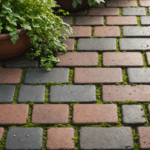As homeowners, it’s crucial to maintain a vigilant eye on the condition of your gutters, as they play an essential role in directing rainwater away from your home. One of the clear indicators that your gutters may need replacement is the presence of visible cracks or splits. While at first glance, small cracks might seem insignificant, they can expand over time, leading to more extensive damage.
Cracks or splits in your gutters can result in leaks, which defeat the entire purpose of having gutters in the first place. When water seeps through these openings, it doesn’t get channeled away from your home’s foundation, potentially leading to structural issues. This can be particularly problematic during heavy rainfall or when snow is melting, as excessive water can cause basement flooding, soil erosion, or damage to your foundation.
In addition to structural concerns, the presence of visible cracks and splits in gutters can also lead to aesthetic problems. Moisture escaping through these gaps can cause unsightly water stains on the exterior of your home and lead to the deterioration of fascia boards and siding.
The table below illustrates a comparison between small, repairable cracks and extensive damage that may warrant a full gutter replacement:
| Aspect | Small, Repairable Cracks | Extensive Damage |
| Size of the Crack | Less than 1 inch | More than 3 inches or widespread throughout the gutter |
| Location | Isolated areas | Multiple sections or joints |
| Repair Costs | Minor, often possible with sealant | Major, possibly exceeding the cost of one section’s replacement |
| Longevity | Temporary fix, may last through a season | Permanent damage, reducing gutter lifespan significantly |
If you’re dealing with minimal cracking, it might be sufficient to apply a specialized sealant or a patch to prolong the life of your gutters temporarily. However, if the cracks are widespread or expanding, it’s often more cost-effective and safer to replace the gutters entirely to avoid potential water damage.
Regular inspections can help you catch these issues early, allowing you to decide whether patching or replacement is the best route. Such proactive maintenance not only preserves the integrity of your home but also saves you money in the long run by avoiding more significant repairs.
peeling paint or rust

Peeling paint or rust on your gutters are telltale signs that a replacement is necessary, as these issues often point to underlying problems that could compromise the effectiveness of your gutter system. This section explains how to assess and address these signs.
1. Identify the Affected Areas:
– Begin by conducting a thorough inspection of your gutters to identify areas where the paint is peeling or where rust has accumulated. Use a ladder safely to access higher sections if necessary.
– Pay particular attention to seams, joints, and corners, as these are often more susceptible to damage.
2. Understand the Causes:
– Peeling paint often results from prolonged exposure to moisture. As gutters are constantly exposed to rain and snow, this peels the protective paint, leaving the underlying metal vulnerable.
– Rust forms when metal is exposed to air and moisture for an extended period, leading to corrosion that can weaken the gutter structure. Common with galvanized steel gutters, rust indicates a loss of metal integrity and potential leaks.
3. Evaluate the Severity:
– If the rust or peeling is isolated to small sections, a temporary fix might suffice. However, widespread damage indicates a systemic issue requiring complete gutter replacement to avoid water damage to your property.
– Check if the rust has eaten through the metal or if the peeling paint is accompanied by other structural damage.
4. Consider Your Options:
– For minor cases, sanding down rust spots and repainting can extend gutter life. Ensure to use rust-inhibiting primers and paints designed for outdoor metal applications.
– When rust has caused significant damage through the metal, the only effective solution is gutter replacement to ensure water is adequately directed away from your home.
5. Take Preventive Measures:
– Maintaining your gutters by regular cleaning and repainting with weather-resistant paint can help prevent the recurrence of peeling and rust.
– Consider investing in gutters made of materials less prone to rust, like aluminum or vinyl, which offer better longevity and require less maintenance.
By addressing peeling paint and rust promptly, you can protect your home from the cascading effects of gutter failure, such as water intrusion and structural damage. Regular inspection and timely intervention not only protect the aesthetics and value of your home but also ensure that the gutter system effectively channels water away, safeguarding your investment.
water damage and mildew
Water damage and the presence of mildew are strong indicators that your gutters may no longer be functioning effectively. When these issues arise, they not only highlight the need for immediate attention but also signify potential risks to your property. Here’s how you can identify and address these problems to maintain a safe and dry environment in your home:
1. Recognize the Warning Signs:
– Look for water stains or streak marks along the siding or fascia where the gutters meet the roof. This often indicates that water is overflowing or leaking from the gutters.
– If you notice mildew or moss growth on the walls or near the foundation, it could be a result of water not being properly diverted away from the house, leading to excess moisture.
2. Understand the Underlying Causes:
– The primary role of gutters is to channel rainwater away from the foundation of your home. If they’re blocked, damaged, or improperly installed, water can spill over the sides.
– Water that escapes can seep into walls, resulting in mildew, which thrives in damp conditions. Over time, this not only damages exterior surfaces but can also infiltrate interior walls, leading to further complications such as rot and pest infestations.
3. Evaluate the Extent of Damage:
– Inspect your gutters for any sagging sections or standing water, which could indicate improper slope or clogs that prevent water from draining.
– Check for signs of water pooling around the base of your home after rainfall. This could contribute to foundation damage, which is costly to repair.
4. Explore Your Options:
– For mild cases where mildew growth is minimal, a thorough cleaning of your gutters and downspouts may suffice to restore functionality. Ensure they are resealed to prevent leaks.
– In cases where the gutters are beyond repair, replacing them with a higher-capacity or seamless option might be necessary. Seamless gutters reduce the likelihood of leaks and provide a more efficient water flow.
5. Implement Preventive Measures:
– Routine maintenance, such as clearing debris and ensuring correct gutter slope, can prevent water damage and mildew.
– Installing gutter guards can help minimize debris accumulation, reducing the chances of clogs.
– Consider upgrading to more robust materials if your region experiences heavy rainfall or if existing gutters repeatedly fail to perform.
By addressing issues of water damage and mildew promptly, you maintain the structural integrity of your home and prevent future expenses associated with serious water-related damages. A proactive approach ensures that your gutter system efficiently serves its purpose, providing peace of mind and long-term protection for your property.
sagging or pulling away
When you notice your gutters starting to sag or pull away from the house, it’s a red flag signaling that your gutter system may be in dire need of replacement. This problem often arises due to heavy accumulation of debris, improper installation, or damage from external forces such as fallen branches. When gutters sag, they fail to maintain the necessary slope for effective water drainage, which can cause water to pool in certain areas rather than being directed away from your home.
One of the immediate issues that sagging gutters can cause is water spilling over the sides, leading to potential water damage on your home’s siding, foundation, and landscape. Overflowing water can also erode soil and damage gardens or pathways next to your house, reflecting the importance of addressing this issue promptly. Moreover, the weight of stagnant water can exacerbate the sagging, potentially leading the gutter to detach completely from the roofline.
To assess this problem properly, you should inspect the gutters for loose or bent hangers, which are the components holding your gutters in place. If you find that these are no longer securing the gutter firmly against the fascia board, it’s a sure sign that either the hangers need replacing or the entire gutter system requires an upgrade to more robust materials and fixtures.
Promptly addressing sagging or pulling gutters is critical not only for maintaining the structural integrity of the gutter system but also for safeguarding your home’s exterior from extensive water damage. It’s advisable to consult a professional for a detailed inspection and to explore replacement options, such as seamless gutter systems, that are designed to fit snugly and perform efficiently. By ensuring your gutters are properly aligned and securely fastened, you can enhance their longevity, ensuring they continue to protect your home effectively during heavy rainfall or harsh weather conditions.
frequent clogs and overflow
Frequent clogs and overflow are clear indicators that your gutters may be on their last legs. When gutters frequently clog, it often points to an underlying issue that might not be easily resolved with mere cleaning. The persistent build-up of leaves, sticks, and other debris hampers the normal flow of water, leading to overflow during heavy rains. This overflow can cause significant damage, including water seeping down the sides of your house, potentially damaging siding and the building’s foundation. Moreover, consistent clogs often mean that your current gutter system lacks proper guards or that the design does not accommodate the surrounding foliage, leading to frequent blockages.
The consequences of allowing clogs and overflow to persist can be severe. Water that spills over can lead to soil erosion around your home’s foundation, and unchecked moisture can encourage mildew and rot in roofs and walls. Additionally, if water is not directed away effectively, it increases the risk of basement flooding, especially in areas with poor drainage. Therefore, witnessing water pouring over the sides of your gutters instead of through the downspouts suggests that a replacement might be necessary to maintain your home’s safety and integrity.
Replacing your gutters with a system that incorporates features such as mesh guards or larger downspouts can significantly improve performance. Modern gutter systems are designed to better handle debris while ensuring seamless water flow, reducing the labor and cost involved in frequent cleanings. Opting for a high-capacity or seamless gutter system can be a proactive measure to combat overflow issues.
In conclusion, keeping your gutter system in optimal condition is crucial for protecting your home from water damage. By recognizing signs such as visible cracks, peeling paint, water damage, sagging, and frequent clogs, homeowners can decide when it’s time for a replacement. Regular maintenance and timely interventions will not only preserve your home’s structural integrity but also save money on costly repairs in the future. Ensuring your gutters function properly will safeguard your property against the damaging effects of uncontrolled water flow and maintain the overall health of your home.

